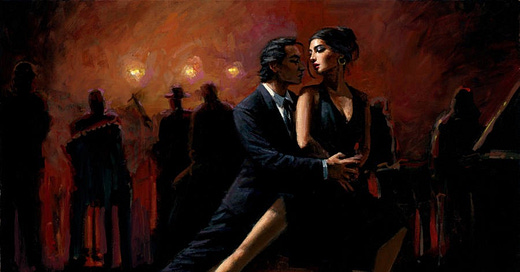Today we continue our journey through dance forms around the world, finding their essence and obtaining wisdom that is applicable not only to the dance but life as a whole (and in the process it may introduce you to a dance form that your soul feels called to).
Previously we explored belly dance and kathak. Belly dance and kathak are solo dances and the ‘juice’ that is extracted from them (and other solo dances that we are to explore in the future) often pertains to self-ownership, confidence, an ability to stand alone and face the fire and judgement of the gazes coming towards you. In contrast, the ‘juice’ of partner dances can lead us towards the wisdom of relational dynamics whether they are delicate and intimate or passionate and intense.
Tango is a partner dance, but it is neither the waltz, with its delicate propriety and formal grace, nor the salsa, whose playfulness and lighter sensuality evoke a more carefree spirit. Tango, instead, is a serpentine waltz, its sensuality entwines with tension, it is a dance of constant yielding and resistance, of ‘squeezing and releasing’ that both binds and frees. In contrast to other partner dances, tango involves an intense physical intimacy—a constant touching, embracing, and the entwining of legs, arms, and bodies, wrapping around one another in a sensual dialogue. Originating in the Rio de la Plata region, the natural border between Argentina and Uruguay, tango emerged in the port areas, often danced in bars and brothels. From these underground beginnings, it has risen to the status of a UNESCO-listed intangible cultural heritage. Most of us likely recall the iconic tango scene from The Scent of a Woman—a moment that cemented the dance in our collective imagination as profoundly sensual and deeply intimate.
Like the most decadent moments of love, the essence of tango thrives on opposites — sensual and sharp, yielding and commanding, vulnerability and fierceness. It is a walking dance, the leading partner, usually the man, takes his partner for a walk. He is not domineering or pushing her into shadows — in fact, his ‘art’ is in how well he can orchestrate the dynamic in which his partner is to shine. The woman yields to her partner’s lead but also asserts her own power through poise and expression. Her yielding is desired, its root confident surrender, not weakness or a lack of agency. She is harmonising with his movements because they resonate with her deepest essence. Her stance is also far from passive — she subtly ‘judges’ her partner, testing his ability to read her and so to evoke her receptivity. If he misreads her, he cannot truly move her, at least not in a way that feels authentic or meaningful.
The male lead in most partner dances also has an aesthetic component as it creates visual balance. A man is usually taller, heavier, stronger and physically larger—a woman attempting to physically move a man would appear awkward and inauthentic, disrupting the aesthetic coherence of the dance.
Keep reading with a 7-day free trial
Subscribe to Volupta to keep reading this post and get 7 days of free access to the full post archives.





